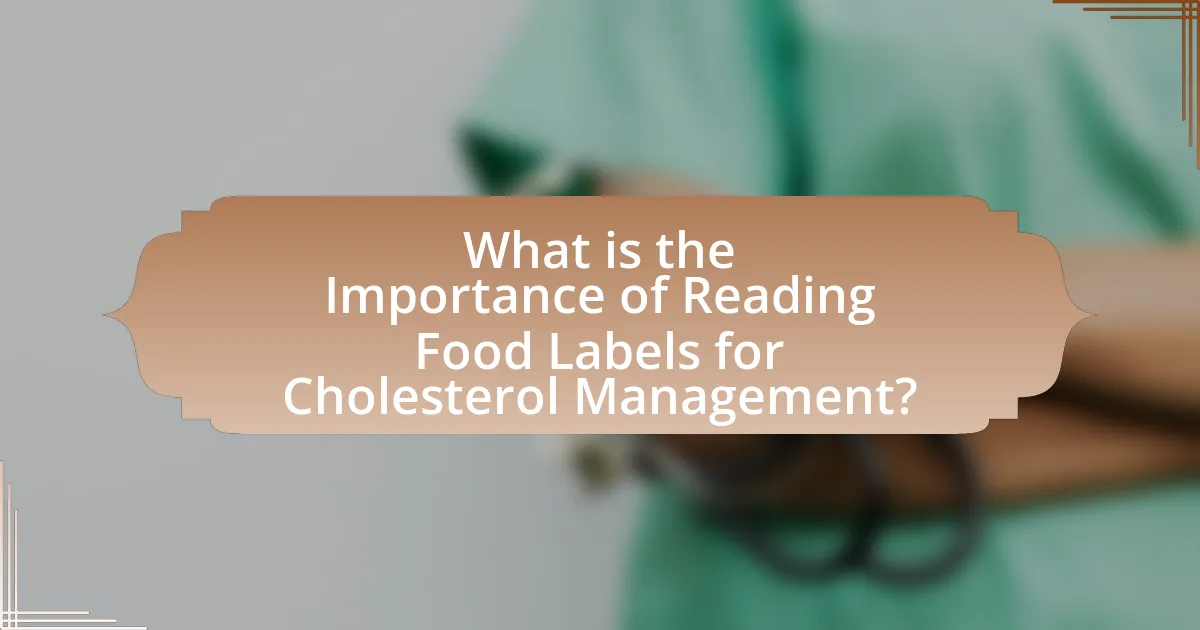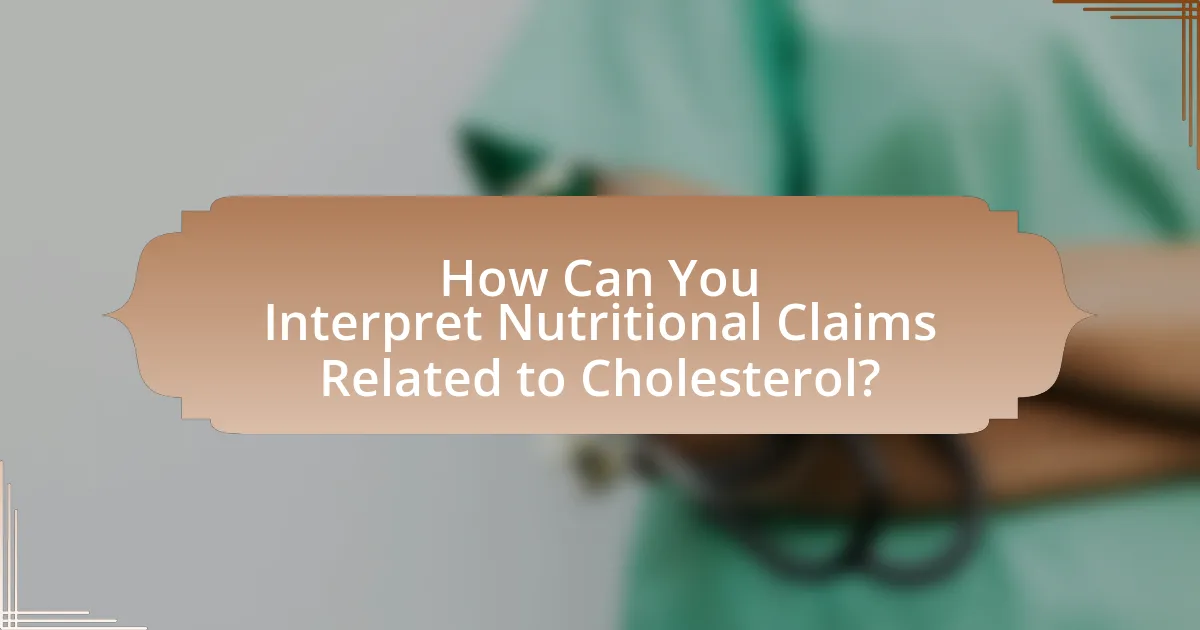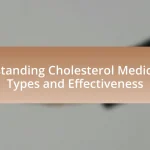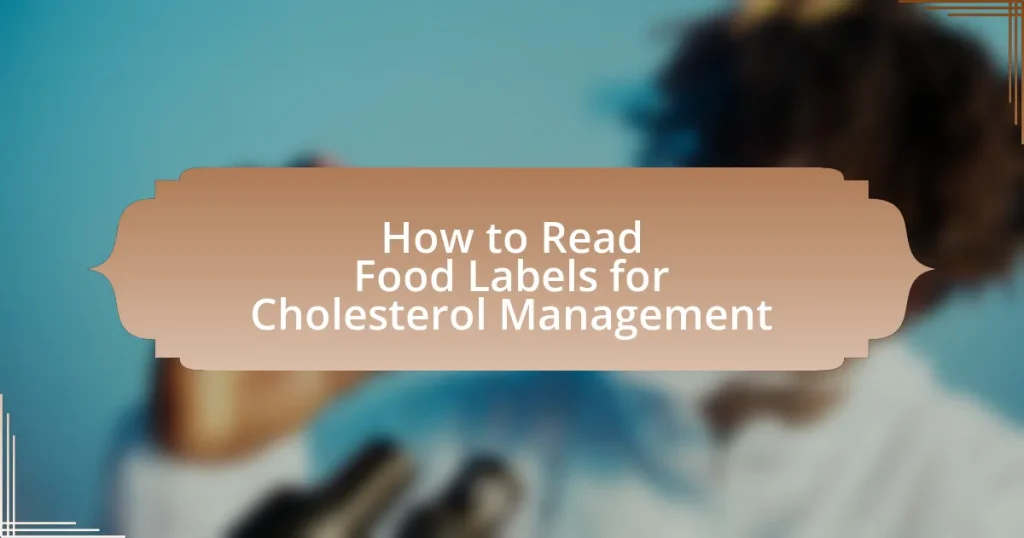The article focuses on the importance of reading food labels for effective cholesterol management. It emphasizes how understanding nutritional information, particularly regarding saturated fats, trans fats, and dietary cholesterol, can help individuals make informed dietary choices that align with health guidelines. Key components to look for on food labels, such as total fat, saturated fat, and cholesterol levels, are outlined, along with the health risks associated with high cholesterol. The article also provides practical tips for interpreting food labels and meal planning to support heart health and reduce the risk of cardiovascular diseases.

What is the Importance of Reading Food Labels for Cholesterol Management?
Reading food labels is crucial for cholesterol management because it enables individuals to identify and limit their intake of saturated fats and trans fats, which can raise cholesterol levels. By examining the nutritional information, consumers can make informed choices that align with dietary guidelines, such as the American Heart Association’s recommendation to keep saturated fat intake to less than 7% of total daily calories. This practice helps in maintaining healthy cholesterol levels, reducing the risk of heart disease, and promoting overall cardiovascular health.
How do food labels help in managing cholesterol levels?
Food labels help in managing cholesterol levels by providing essential information about the fat content, specifically saturated and trans fats, which directly impact cholesterol levels. By reading food labels, individuals can identify products that are low in these harmful fats, as high intake of saturated and trans fats can raise LDL cholesterol, increasing the risk of heart disease. For instance, the American Heart Association recommends limiting saturated fat to less than 7% of total daily calories and avoiding trans fats altogether. Thus, food labels serve as a critical tool for consumers to make informed dietary choices that support heart health and cholesterol management.
What specific information on food labels is crucial for cholesterol management?
The specific information on food labels crucial for cholesterol management includes the total fat content, saturated fat, trans fat, and dietary cholesterol levels. These components directly impact blood cholesterol levels; for instance, saturated and trans fats can raise LDL (bad cholesterol) levels, while dietary cholesterol can also contribute to overall cholesterol levels in some individuals. The American Heart Association recommends limiting saturated fat to less than 7% of total daily calories and avoiding trans fats altogether to effectively manage cholesterol levels.
How can understanding food labels influence dietary choices?
Understanding food labels can significantly influence dietary choices by providing essential information about nutritional content, including cholesterol levels, serving sizes, and ingredient lists. When individuals comprehend these labels, they can make informed decisions that align with their health goals, such as managing cholesterol intake. For instance, a study published in the Journal of Nutrition found that consumers who regularly read food labels are more likely to choose lower-fat and lower-cholesterol options, leading to improved dietary quality. This understanding empowers individuals to select foods that support heart health and reduce the risk of cardiovascular diseases.
Why is cholesterol management essential for overall health?
Cholesterol management is essential for overall health because it helps prevent cardiovascular diseases, including heart attacks and strokes. High levels of low-density lipoprotein (LDL) cholesterol can lead to plaque buildup in arteries, increasing the risk of atherosclerosis. According to the American Heart Association, maintaining healthy cholesterol levels can reduce the risk of heart disease by up to 30%. Regular monitoring and management of cholesterol through diet, exercise, and medication when necessary are crucial for maintaining cardiovascular health and overall well-being.
What are the health risks associated with high cholesterol levels?
High cholesterol levels significantly increase the risk of cardiovascular diseases, including heart attacks and strokes. Elevated low-density lipoprotein (LDL) cholesterol can lead to the buildup of plaques in arteries, a condition known as atherosclerosis, which narrows blood vessels and restricts blood flow. According to the American Heart Association, individuals with high LDL cholesterol are twice as likely to develop heart disease compared to those with optimal levels. Additionally, high cholesterol can contribute to pancreatitis, a painful inflammation of the pancreas.
How does cholesterol impact heart health?
Cholesterol significantly impacts heart health by influencing the risk of cardiovascular diseases. High levels of low-density lipoprotein (LDL) cholesterol can lead to the buildup of plaque in arteries, which narrows them and restricts blood flow, increasing the likelihood of heart attacks and strokes. According to the American Heart Association, maintaining healthy cholesterol levels is crucial for reducing these risks, as elevated LDL cholesterol is a well-established risk factor for heart disease.

What Key Components Should You Look for on Food Labels?
Key components to look for on food labels include total fat, saturated fat, trans fat, cholesterol, sodium, total carbohydrates, dietary fiber, sugars, and protein. These components are crucial for managing cholesterol levels, as high saturated and trans fats can raise LDL cholesterol, while dietary fiber can help lower it. The American Heart Association recommends limiting saturated fat to less than 7% of total daily calories and avoiding trans fats altogether to maintain heart health.
How do you identify total fat and saturated fat on food labels?
To identify total fat and saturated fat on food labels, locate the “Nutrition Facts” panel on the packaging. This panel lists total fat in grams, typically found at the top, followed by a breakdown that includes saturated fat. The amount of saturated fat is usually indicated directly beneath total fat, also in grams. According to the FDA, food labels must clearly display these values to help consumers manage their dietary fat intake effectively.
What is the difference between saturated fat and trans fat?
Saturated fat and trans fat are both types of dietary fats, but they differ in their chemical structure and health effects. Saturated fat, found in animal products like meat and dairy, consists of fatty acid chains that are fully saturated with hydrogen atoms, which can raise LDL cholesterol levels in the blood. In contrast, trans fat is created through an industrial process that adds hydrogen to liquid vegetable oils to make them solid, often found in processed foods, and is known to increase the risk of heart disease by raising LDL cholesterol while lowering HDL cholesterol. The American Heart Association recommends limiting both types of fat to maintain heart health.
How do these fats affect cholesterol levels?
Saturated and trans fats increase LDL cholesterol levels, which is often referred to as “bad” cholesterol. High levels of LDL cholesterol are associated with an increased risk of heart disease and stroke. For instance, the American Heart Association recommends limiting saturated fat intake to less than 6% of total daily calories to maintain healthy cholesterol levels. Additionally, trans fats, commonly found in partially hydrogenated oils, can raise LDL cholesterol while lowering HDL cholesterol, the “good” cholesterol, further exacerbating cardiovascular risks.
What role does dietary cholesterol play in your diet?
Dietary cholesterol plays a role in the body’s cholesterol levels and overall health. It is found in animal-based foods and can influence blood cholesterol levels, although recent research indicates that for most people, dietary cholesterol has a smaller impact on blood cholesterol than previously thought. The American Heart Association states that saturated and trans fats have a more significant effect on blood cholesterol levels than dietary cholesterol itself. Therefore, while dietary cholesterol is a component of the diet, its role is less critical than the types of fats consumed.
How much dietary cholesterol is considered safe?
The American Heart Association recommends that individuals limit their dietary cholesterol intake to less than 300 milligrams per day. This guideline is based on research indicating that high dietary cholesterol can contribute to elevated blood cholesterol levels, which is a risk factor for heart disease. Studies have shown that reducing dietary cholesterol can lead to improved heart health outcomes, reinforcing the importance of adhering to this recommendation.
What foods are high in dietary cholesterol?
Foods high in dietary cholesterol include egg yolks, organ meats such as liver, shellfish like shrimp and crab, and full-fat dairy products such as cheese and butter. For instance, a single large egg yolk contains approximately 186 milligrams of cholesterol, while a 3-ounce serving of beef liver can contain around 330 milligrams. Shellfish, particularly shrimp, can have about 166 milligrams of cholesterol per 3-ounce serving. These foods contribute significantly to dietary cholesterol intake and should be monitored for those managing cholesterol levels.

How Can You Interpret Nutritional Claims Related to Cholesterol?
To interpret nutritional claims related to cholesterol, examine the food label for specific terms such as “cholesterol-free,” “low cholesterol,” and “reduced cholesterol.” These terms indicate the amount of cholesterol present in the product, with “cholesterol-free” meaning less than 2 mg of cholesterol per serving, and “low cholesterol” indicating 20 mg or less per serving. Additionally, “reduced cholesterol” signifies a decrease of at least 25% in cholesterol compared to a standard product. Understanding these definitions helps consumers make informed choices that align with dietary guidelines, which recommend limiting cholesterol intake to less than 300 mg per day for most individuals.
What do terms like “low cholesterol” or “cholesterol-free” mean?
The term “low cholesterol” indicates that a food product contains 20 milligrams or less of cholesterol per serving, while “cholesterol-free” means that the product contains less than 2 milligrams of cholesterol per serving and also has no saturated fat. These definitions are regulated by the U.S. Food and Drug Administration (FDA) to help consumers make informed dietary choices, particularly for managing cholesterol levels.
How can misleading labels affect your cholesterol management?
Misleading labels can significantly hinder cholesterol management by providing inaccurate information about the fat content and cholesterol levels in food products. For instance, a product labeled as “low-fat” may still contain high levels of saturated fats, which can raise LDL cholesterol levels. Research indicates that consumers often rely on these labels without understanding the nutritional implications, leading to poor dietary choices that can exacerbate cholesterol issues. A study published in the Journal of the American Dietetic Association found that individuals misled by labels were more likely to consume foods that negatively impacted their cholesterol levels, highlighting the importance of accurate labeling for effective cholesterol management.
What should you know about “heart-healthy” claims?
“Heart-healthy” claims indicate that a food product meets specific criteria set by regulatory agencies, such as the FDA, regarding its nutritional content. These claims typically suggest that the product can help reduce the risk of heart disease, often by being low in saturated fat, cholesterol, and sodium while being high in beneficial nutrients like fiber. For instance, a product labeled as “heart-healthy” must contain less than 1 gram of saturated fat and less than 20 milligrams of cholesterol per serving. Understanding these claims can aid consumers in making informed dietary choices that support cardiovascular health.
How can you compare products effectively using food labels?
To compare products effectively using food labels, focus on key nutritional components such as total fat, saturated fat, trans fat, cholesterol, and sodium. These components directly impact cholesterol levels and heart health. For instance, a product with lower saturated fat and trans fat is generally better for cholesterol management. Additionally, examining serving sizes is crucial, as it allows for accurate comparisons between similar products. Research indicates that diets low in saturated and trans fats can significantly reduce LDL cholesterol levels, supporting the importance of scrutinizing these labels for informed choices.
What are the best practices for comparing nutritional information?
The best practices for comparing nutritional information include examining serving sizes, understanding nutrient content, and evaluating ingredient lists. First, ensure that the serving sizes of the products being compared are identical, as this allows for an accurate assessment of calories and nutrients. Next, focus on key nutrients relevant to cholesterol management, such as saturated fat, trans fat, and dietary fiber, as these directly impact heart health. Additionally, scrutinize the ingredient list for sources of unhealthy fats and added sugars, which can contribute to elevated cholesterol levels. By following these practices, consumers can make informed choices that support their dietary goals.
How can serving sizes impact your cholesterol management?
Serving sizes significantly impact cholesterol management by determining the amount of saturated fat and cholesterol consumed in a meal. When individuals adhere to recommended serving sizes, they can better control their intake of these substances, which are known to raise LDL cholesterol levels. For instance, the American Heart Association recommends limiting saturated fat to less than 6% of total daily calories; thus, understanding serving sizes helps individuals make informed choices that align with this guideline. By accurately measuring serving sizes, individuals can avoid excessive consumption of high-cholesterol foods, ultimately aiding in the maintenance of healthier cholesterol levels.
What practical tips can help you read food labels for better cholesterol management?
To effectively read food labels for better cholesterol management, focus on identifying the total fat, saturated fat, and trans fat content. Total fat should be limited to less than 30% of daily caloric intake, while saturated fat should comprise less than 10%, and trans fat should be avoided entirely, as per the American Heart Association guidelines. Additionally, look for foods labeled as “low cholesterol” or “cholesterol-free,” which can aid in maintaining healthy cholesterol levels. Checking the serving size is crucial, as it helps in accurately assessing the fat content per serving.
How can meal planning assist in managing cholesterol through food labels?
Meal planning assists in managing cholesterol by enabling individuals to make informed food choices based on food labels. By reviewing food labels, individuals can identify the levels of saturated fats, trans fats, and cholesterol in products, which are critical for cholesterol management. For instance, the American Heart Association recommends limiting saturated fat to less than 7% of total daily calories and avoiding trans fats altogether to help lower LDL cholesterol levels. Meal planning allows for the selection of foods that align with these guidelines, promoting heart health and reducing the risk of cardiovascular disease.
What resources are available to help you understand food labels better?
Resources available to help understand food labels better include the U.S. Food and Drug Administration (FDA) website, which provides detailed information on how to read nutrition labels, including serving sizes, nutrient content, and ingredient lists. Additionally, the American Heart Association offers guidelines specifically focused on cholesterol management, emphasizing the importance of understanding saturated fats and trans fats on labels. Educational materials from registered dietitians and nutritionists also serve as valuable resources, offering personalized insights into interpreting food labels in the context of individual dietary needs.










